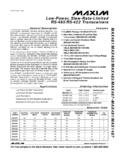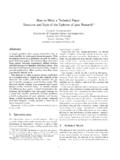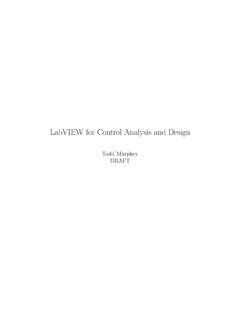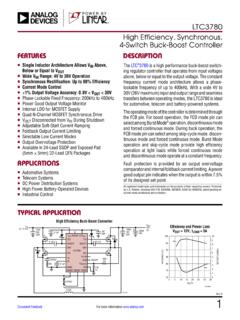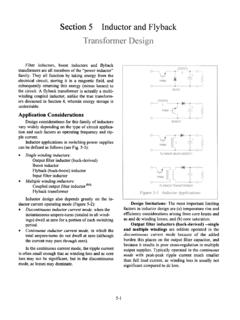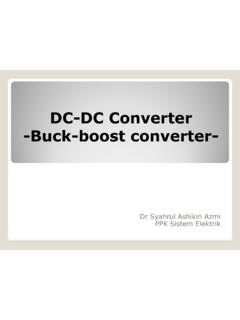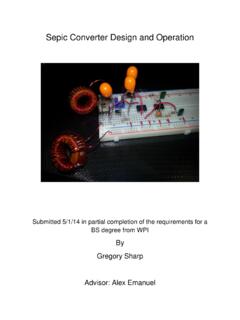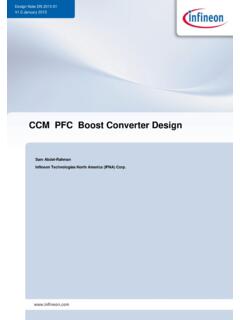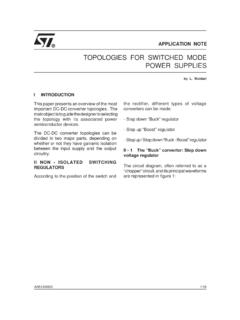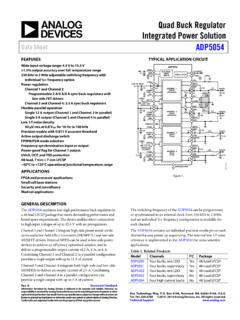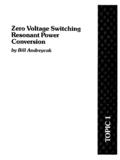Transcription of DC-DC Power Converters
1 Article in Wiley Encyclopedia of Electrical and Electronics Engineering DC-DC Power Converters Robert W. Erickson Department of Electrical and Computer Engineering University of Colorado Boulder, CO 80309-0425 DC-DC Power Converters are employed in a variety of applications, including Power supplies for personal computers, office equipment, spacecraft Power systems, laptop computers, and telecommunications equipment, as well as dc motor drives. The input to a DC-DC converter is an unregulated dc voltage Vg.
2 The converter produces a regulated output voltage V, having a magnitude (and possibly polarity) that differs from Vg. For example, in a computer off-line Power supply, the 120 V or 240 V ac utility voltage is rectified, producing a dc voltage of approximately 170 V or 340 V, respectively. A DC-DC converter then reduces the voltage to the regulated 5 V or V required by the processor ICs. high efficiency is invariably required, since cooling of inefficient Power Converters is difficult and expensive.
3 The ideal DC-DC converter exhibits 100% efficiency ; in practice, efficiencies of 70% to 95% are typically obtained. This is achieved using switched-mode, or chopper, circuits whose elements dissipate negligible Power . Pulse-width modulation (PWM) allows control and regulation of the total output voltage. This approach is also employed in applications involving alternating current, including high - efficiency dc-ac Power Converters (inverters and Power amplifiers), ac-ac Power Converters , and some ac-dc Power Converters (low-harmonic rectifiers).
4 A basic DC-DC converter circuit known as the buck converter is illustrated in Fig. 1. A single -pole double-throw (SPDT) switch is connected to the dc input voltage Vg as shown. The switch output voltage + VgLCR12+V DcinputSwitch networkLow-pass filterLoadDc output(a)+vs(t) vs(t)VgDTs(1 D)Ts0tSwitchposition:121Vs = DVg(b) Figure 1. The buck converter consists of a switch network that reduces the dc component of voltage, and a low-pass filter that removes the high -frequency switching harmonics: (a) schematic, (b) switch voltage waveform.
5 Vs(t) is equal to Vg when the switch is in position 1, and is equal to zero when the switch is in position 2. The switch position is varies periodically, such that vs(t) is a rectangular waveform having period Ts and duty cycle D. The duty cycle is equal to the fraction of time that the switch is connected in position 1, and hence 0 D 1. The switching frequency fs is equal to 1/Ts. In practice, the SPDT switch is realized using semiconductor devices such as diodes, Power MOSFETs, IGBTs, BJTs, or thyristors.
6 Typical switching frequencies lie in the range 1 kHz to 1 MHz, depending on the speed of the semiconductor devices. The switch network changes the dc component of the voltage. By Fourier analysis, the dc component of a waveform is given by its average value. The average value of vs(t) is given by Vs=1 Tsvs(t)dt0Ts=DVg (1) The integral is equal to the area under the waveform, or the height Vg multiplied by the time DTs.
7 It can be seen that the switch network reduces the dc component of the voltage by a factor equal to the duty cycle D. Since 0 D 1, the dc component of Vs is less than or equal to Vg. The Power dissipated by the switch network is ideally equal to zero. When the switch contacts are closed, then the voltage across the contacts is equal to zero and hence the Power dissipation is zero. When the switch contacts are open, then there is zero current and the Power dissipation is again equal to zero. Therefore, the ideal switch network is able to change the dc component of voltage without dissipation of Power .
8 In addition to the desired dc voltage component Vs, the switch waveform vs(t) also contains undesired harmonics of the switching frequency. In most applications, these harmonics must be removed, such that the converter output voltage v(t) is essentially equal to the dc component V = Vs. A low-pass filter is employed for this purpose. The converter of Fig. 1 contains a single -section L-C low-pass filter. The filter has corner frequency f0 given by f0=12 LC (2) The corner frequency f0 is chosen to be sufficiently less than the switching frequency fs, so that the filter essentially passes only the dc component of vs(t).
9 To the extent that the inductor and capacitor are ideal, the filter removes the switching harmonics without dissipation of Power . Thus, the converter produces a dc output voltage whose magnitude is controllable via the duty cycle D, using circuit elements that (ideally) do not dissipate Power . The conversion ratio M(D) is defined as the ratio of the dc output voltage V to the dc input voltage Vg under steady-state conditions: M(D)=VVg (3) For the buck converter , M(D) is given by M(D)=D (4) This equation is plotted in Fig.
10 2. It can be seen that the dc output voltage V is controllable between 0 and Vg, by adjustment of the duty cycle D. Figure 3 illustrates one way to realize the switch network in the buck converter , using a Power MOSFET and diode. A gate drive circuit switches the MOSFET between the conducting (on) and blocking (off) states, as commanded by a logic signal (t). When (t) is high (for 0 < t < DTs), then MOSFET Q1 conducts with negligible drain-to-source voltage. Hence, vs(t) is approximately equal to Vg, and the diode is reverse-biased.
